Business Law: Exploring the English Legal System and Its Applications
VerifiedAdded on 2024/04/25
|16
|5668
|267
Report
AI Summary
This report provides a comprehensive overview of the English legal system, focusing on its structure, sources of law, and the role of government in law-making. It explores the differences between statutory and common law and their application in justice courts. The report also details employers' legal obligations regarding occupational health and safety, workers' compensation, harassment, and equal opportunities, and examines the potential impact of employment and contract law on businesses, using a case study to illustrate these points. Furthermore, it suggests appropriate legal solutions for business problems, justifying them with relevant statutes and case law. The report concludes by explaining the concept and benefits of alternative dispute resolution (ADR) processes and recommending an alternative legal solution to a business problem, highlighting the advantages of ADR methods like arbitration, mediation, and negotiation.
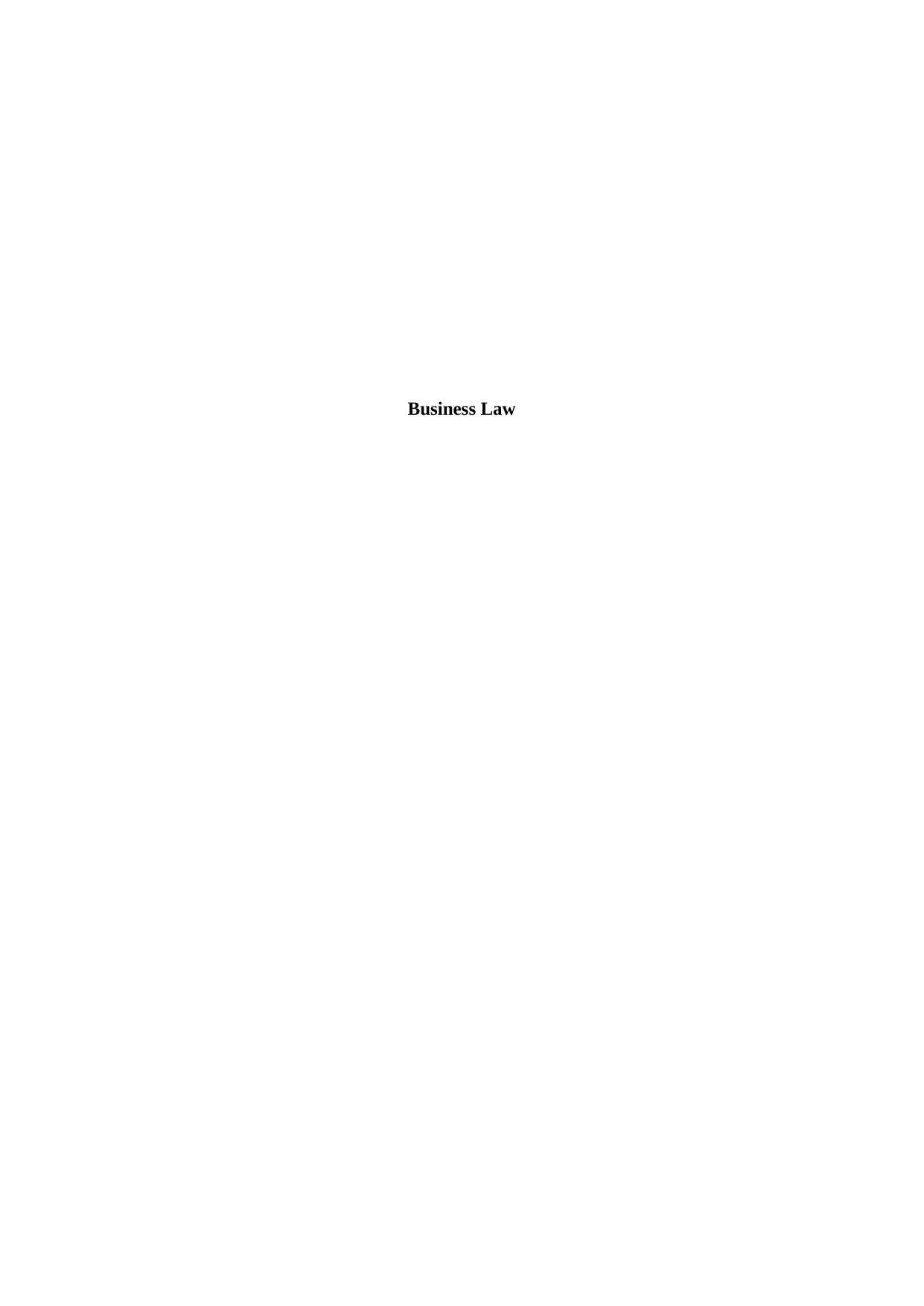
Business Law
Paraphrase This Document
Need a fresh take? Get an instant paraphrase of this document with our AI Paraphraser
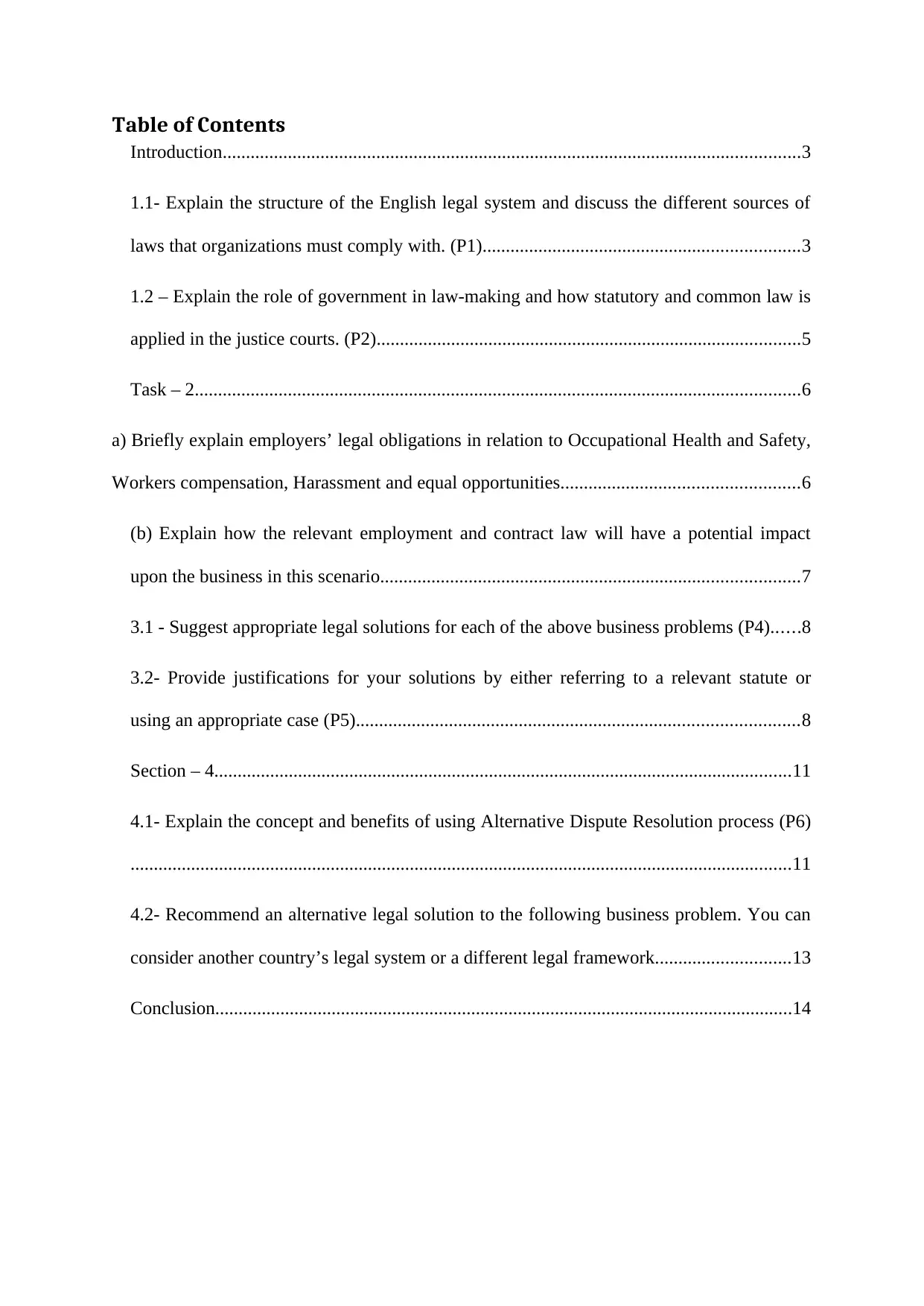
Table of Contents
Introduction............................................................................................................................3
1.1- Explain the structure of the English legal system and discuss the different sources of
laws that organizations must comply with. (P1)....................................................................3
1.2 – Explain the role of government in law-making and how statutory and common law is
applied in the justice courts. (P2)...........................................................................................5
Task – 2..................................................................................................................................6
a) Briefly explain employers’ legal obligations in relation to Occupational Health and Safety,
Workers compensation, Harassment and equal opportunities...................................................6
(b) Explain how the relevant employment and contract law will have a potential impact
upon the business in this scenario..........................................................................................7
3.1 - Suggest appropriate legal solutions for each of the above business problems (P4)......8
3.2- Provide justifications for your solutions by either referring to a relevant statute or
using an appropriate case (P5)...............................................................................................8
Section – 4............................................................................................................................11
4.1- Explain the concept and benefits of using Alternative Dispute Resolution process (P6)
..............................................................................................................................................11
4.2- Recommend an alternative legal solution to the following business problem. You can
consider another country’s legal system or a different legal framework.............................13
Conclusion............................................................................................................................14
Introduction............................................................................................................................3
1.1- Explain the structure of the English legal system and discuss the different sources of
laws that organizations must comply with. (P1)....................................................................3
1.2 – Explain the role of government in law-making and how statutory and common law is
applied in the justice courts. (P2)...........................................................................................5
Task – 2..................................................................................................................................6
a) Briefly explain employers’ legal obligations in relation to Occupational Health and Safety,
Workers compensation, Harassment and equal opportunities...................................................6
(b) Explain how the relevant employment and contract law will have a potential impact
upon the business in this scenario..........................................................................................7
3.1 - Suggest appropriate legal solutions for each of the above business problems (P4)......8
3.2- Provide justifications for your solutions by either referring to a relevant statute or
using an appropriate case (P5)...............................................................................................8
Section – 4............................................................................................................................11
4.1- Explain the concept and benefits of using Alternative Dispute Resolution process (P6)
..............................................................................................................................................11
4.2- Recommend an alternative legal solution to the following business problem. You can
consider another country’s legal system or a different legal framework.............................13
Conclusion............................................................................................................................14

Introduction
Various types of laws exist in the English Legal system. The English legal system mainly has
two types of laws in the society. The first one is the Civil law and the second one is the
Criminal law (Huxley-Binns et al.,2017). The Supreme Court is at the apex of the country
and the subordinate courts under it abide by the orders and instructions provided by the
Supreme Court. The judges of the court follow the common law. Nowadays, the government
is encouraging some alternative methods of law called the ADR methods. The purpose of
introducing these alternative laws is to avoid the lengthy procedure of a case in the court of
law and provide the parties to the disputes the judgement in a simple and easy manner in a
cost-effective method. The parties to the disputes can avoid hassles at the time of proceeding
a suit in a court of law. The three types of proceedings under this ADR method are
Arbitration, Mediation and the Negotiation process respectively. Both the individuals and the
business organizations may follow these procedures in a society. The learner, in the society,
will have a vast idea regarding the various types of laws and their applications in various
situations in our society.
Task -1
1.1- Explain the structure of the English legal system and discuss the different sources
of laws that organizations must comply with. (P1)
The English Laws, influenced by the Roman Laws has been enacted in many countries in
Europe. For enactment of a new law, the Bill has to be passed at first . For passing a bill, first
the approval from House of Parliament has to be approved and then the ascent from the
Queen has to be approved. So, in English legal system, the House of Parliament and the
Queen are concerned with enacting a new law (Mason et al.,2015).
Enforcement of law
In the United Kingdom, the law is enforced by the various agencies. Such agencies are
enlisted under the governmental bodies (Wigmore, 2015).
National Law enforcement bodies: National Crime Agency, British Transport
police and special Police Forces are enlisted under National Law enforcement bodies.
Territorial Police forces: Police authorities fall under this category.
Miscellaneous police forces: These are as per older legislations.
Various types of laws exist in the English Legal system. The English legal system mainly has
two types of laws in the society. The first one is the Civil law and the second one is the
Criminal law (Huxley-Binns et al.,2017). The Supreme Court is at the apex of the country
and the subordinate courts under it abide by the orders and instructions provided by the
Supreme Court. The judges of the court follow the common law. Nowadays, the government
is encouraging some alternative methods of law called the ADR methods. The purpose of
introducing these alternative laws is to avoid the lengthy procedure of a case in the court of
law and provide the parties to the disputes the judgement in a simple and easy manner in a
cost-effective method. The parties to the disputes can avoid hassles at the time of proceeding
a suit in a court of law. The three types of proceedings under this ADR method are
Arbitration, Mediation and the Negotiation process respectively. Both the individuals and the
business organizations may follow these procedures in a society. The learner, in the society,
will have a vast idea regarding the various types of laws and their applications in various
situations in our society.
Task -1
1.1- Explain the structure of the English legal system and discuss the different sources
of laws that organizations must comply with. (P1)
The English Laws, influenced by the Roman Laws has been enacted in many countries in
Europe. For enactment of a new law, the Bill has to be passed at first . For passing a bill, first
the approval from House of Parliament has to be approved and then the ascent from the
Queen has to be approved. So, in English legal system, the House of Parliament and the
Queen are concerned with enacting a new law (Mason et al.,2015).
Enforcement of law
In the United Kingdom, the law is enforced by the various agencies. Such agencies are
enlisted under the governmental bodies (Wigmore, 2015).
National Law enforcement bodies: National Crime Agency, British Transport
police and special Police Forces are enlisted under National Law enforcement bodies.
Territorial Police forces: Police authorities fall under this category.
Miscellaneous police forces: These are as per older legislations.
⊘ This is a preview!⊘
Do you want full access?
Subscribe today to unlock all pages.

Trusted by 1+ million students worldwide

Constituents of Legal system: The Supreme court is at the summit of the country and all the
Civil and Criminal courts abide by the orders of this Court. The Court of appeal is also under
the Supreme Court. High Courts follow the Court of appeal. Court of Appeal, Crown Court
and the Magistrate Courts handle criminal cases (Loughlin et al.,2016).
Supreme Court: The Supreme Court is at the summit of the country and handles public
cases (Chemerinsky, 2016).
Court of Appeal: It is under the Supreme Court and both the civil and criminal cases are
handled by this court.
High Courts: High Courts are under Court of Appeal and they handle civil matters (Stephen,
2014 ).
Crown Courts: Crown Court handles the criminal cases.
Country Court: Civil and family issues are handled here.
Magistrate courts: The primary matters in related to criminal case are handled in this court
(Moibi et al.,2014).
Purpose, evaluation and sources of laws
The main purpose of enforcing laws in the society is to protect the society from various
criminal activities and lessen the crime in the society. The enforcement of law in the society
is to provide judgement for both individuals and business organizations.
In the stages of evaluation of laws, firstly the Bill is passed and then laws are amended if
necessary.
There exist various sources of laws in the United Kingdom and they are European
Convention on Human Rights, Case laws, EU laws, statutory laws and legislations. The
European Convention on Human Rights is concerned with the human rights to be
safeguarded. These human rights are safeguarded through some equal opportunities. The
judges gain some special types of experiences through cases and the case laws are formed
based on those experiences. The European laws are concerned with the pay-backs, payment
of salaries, child labour etc (Ehrenberg et al.,2016). The approval from the Members of the
House is required for legislations and this also needs the approval of House of Lords and the
ascent of Queen.
Civil and Criminal courts abide by the orders of this Court. The Court of appeal is also under
the Supreme Court. High Courts follow the Court of appeal. Court of Appeal, Crown Court
and the Magistrate Courts handle criminal cases (Loughlin et al.,2016).
Supreme Court: The Supreme Court is at the summit of the country and handles public
cases (Chemerinsky, 2016).
Court of Appeal: It is under the Supreme Court and both the civil and criminal cases are
handled by this court.
High Courts: High Courts are under Court of Appeal and they handle civil matters (Stephen,
2014 ).
Crown Courts: Crown Court handles the criminal cases.
Country Court: Civil and family issues are handled here.
Magistrate courts: The primary matters in related to criminal case are handled in this court
(Moibi et al.,2014).
Purpose, evaluation and sources of laws
The main purpose of enforcing laws in the society is to protect the society from various
criminal activities and lessen the crime in the society. The enforcement of law in the society
is to provide judgement for both individuals and business organizations.
In the stages of evaluation of laws, firstly the Bill is passed and then laws are amended if
necessary.
There exist various sources of laws in the United Kingdom and they are European
Convention on Human Rights, Case laws, EU laws, statutory laws and legislations. The
European Convention on Human Rights is concerned with the human rights to be
safeguarded. These human rights are safeguarded through some equal opportunities. The
judges gain some special types of experiences through cases and the case laws are formed
based on those experiences. The European laws are concerned with the pay-backs, payment
of salaries, child labour etc (Ehrenberg et al.,2016). The approval from the Members of the
House is required for legislations and this also needs the approval of House of Lords and the
ascent of Queen.
Paraphrase This Document
Need a fresh take? Get an instant paraphrase of this document with our AI Paraphraser
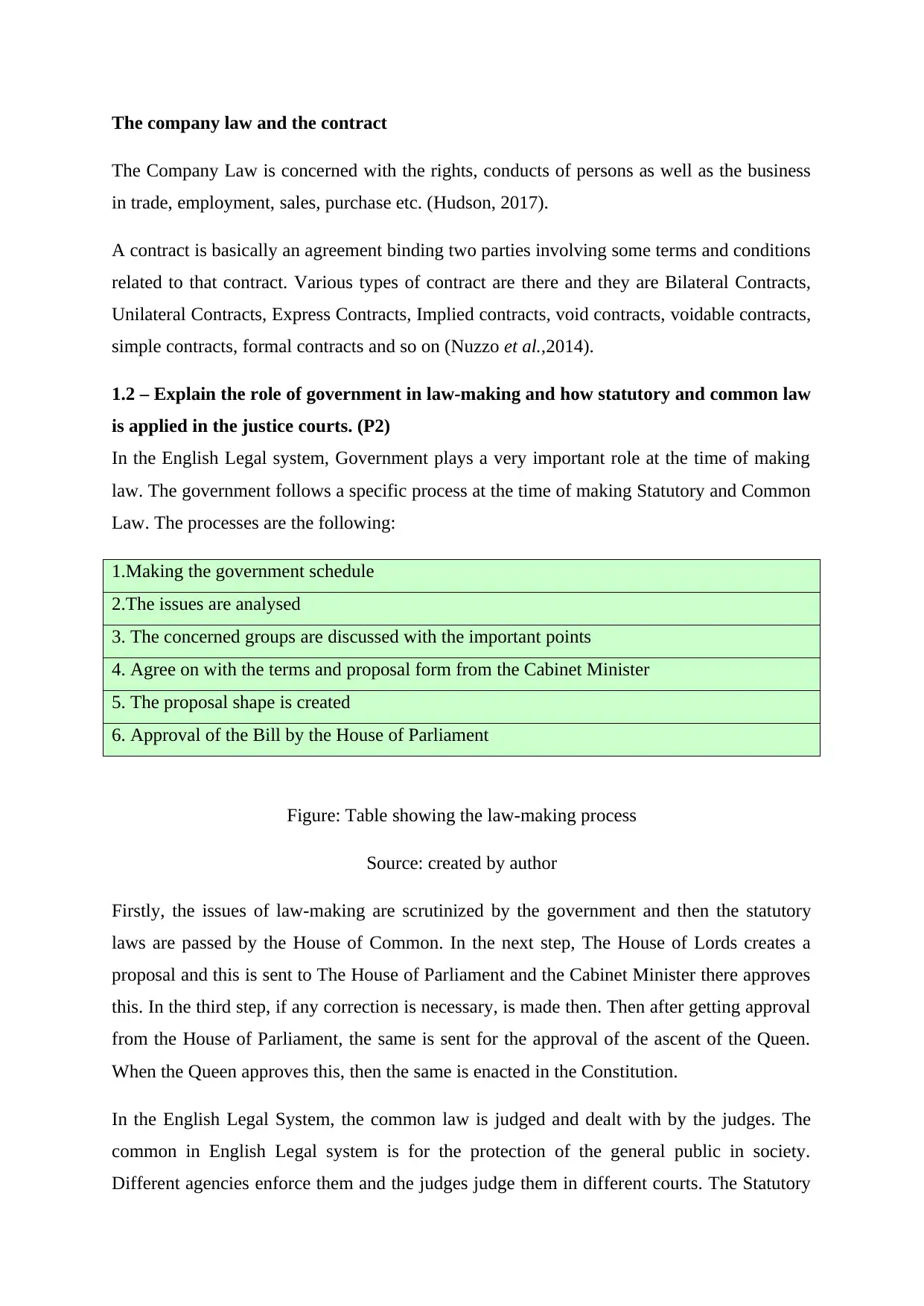
The company law and the contract
The Company Law is concerned with the rights, conducts of persons as well as the business
in trade, employment, sales, purchase etc. (Hudson, 2017).
A contract is basically an agreement binding two parties involving some terms and conditions
related to that contract. Various types of contract are there and they are Bilateral Contracts,
Unilateral Contracts, Express Contracts, Implied contracts, void contracts, voidable contracts,
simple contracts, formal contracts and so on (Nuzzo et al.,2014).
1.2 – Explain the role of government in law-making and how statutory and common law
is applied in the justice courts. (P2)
In the English Legal system, Government plays a very important role at the time of making
law. The government follows a specific process at the time of making Statutory and Common
Law. The processes are the following:
1.Making the government schedule
2.The issues are analysed
3. The concerned groups are discussed with the important points
4. Agree on with the terms and proposal form from the Cabinet Minister
5. The proposal shape is created
6. Approval of the Bill by the House of Parliament
Figure: Table showing the law-making process
Source: created by author
Firstly, the issues of law-making are scrutinized by the government and then the statutory
laws are passed by the House of Common. In the next step, The House of Lords creates a
proposal and this is sent to The House of Parliament and the Cabinet Minister there approves
this. In the third step, if any correction is necessary, is made then. Then after getting approval
from the House of Parliament, the same is sent for the approval of the ascent of the Queen.
When the Queen approves this, then the same is enacted in the Constitution.
In the English Legal System, the common law is judged and dealt with by the judges. The
common in English Legal system is for the protection of the general public in society.
Different agencies enforce them and the judges judge them in different courts. The Statutory
The Company Law is concerned with the rights, conducts of persons as well as the business
in trade, employment, sales, purchase etc. (Hudson, 2017).
A contract is basically an agreement binding two parties involving some terms and conditions
related to that contract. Various types of contract are there and they are Bilateral Contracts,
Unilateral Contracts, Express Contracts, Implied contracts, void contracts, voidable contracts,
simple contracts, formal contracts and so on (Nuzzo et al.,2014).
1.2 – Explain the role of government in law-making and how statutory and common law
is applied in the justice courts. (P2)
In the English Legal system, Government plays a very important role at the time of making
law. The government follows a specific process at the time of making Statutory and Common
Law. The processes are the following:
1.Making the government schedule
2.The issues are analysed
3. The concerned groups are discussed with the important points
4. Agree on with the terms and proposal form from the Cabinet Minister
5. The proposal shape is created
6. Approval of the Bill by the House of Parliament
Figure: Table showing the law-making process
Source: created by author
Firstly, the issues of law-making are scrutinized by the government and then the statutory
laws are passed by the House of Common. In the next step, The House of Lords creates a
proposal and this is sent to The House of Parliament and the Cabinet Minister there approves
this. In the third step, if any correction is necessary, is made then. Then after getting approval
from the House of Parliament, the same is sent for the approval of the ascent of the Queen.
When the Queen approves this, then the same is enacted in the Constitution.
In the English Legal System, the common law is judged and dealt with by the judges. The
common in English Legal system is for the protection of the general public in society.
Different agencies enforce them and the judges judge them in different courts. The Statutory
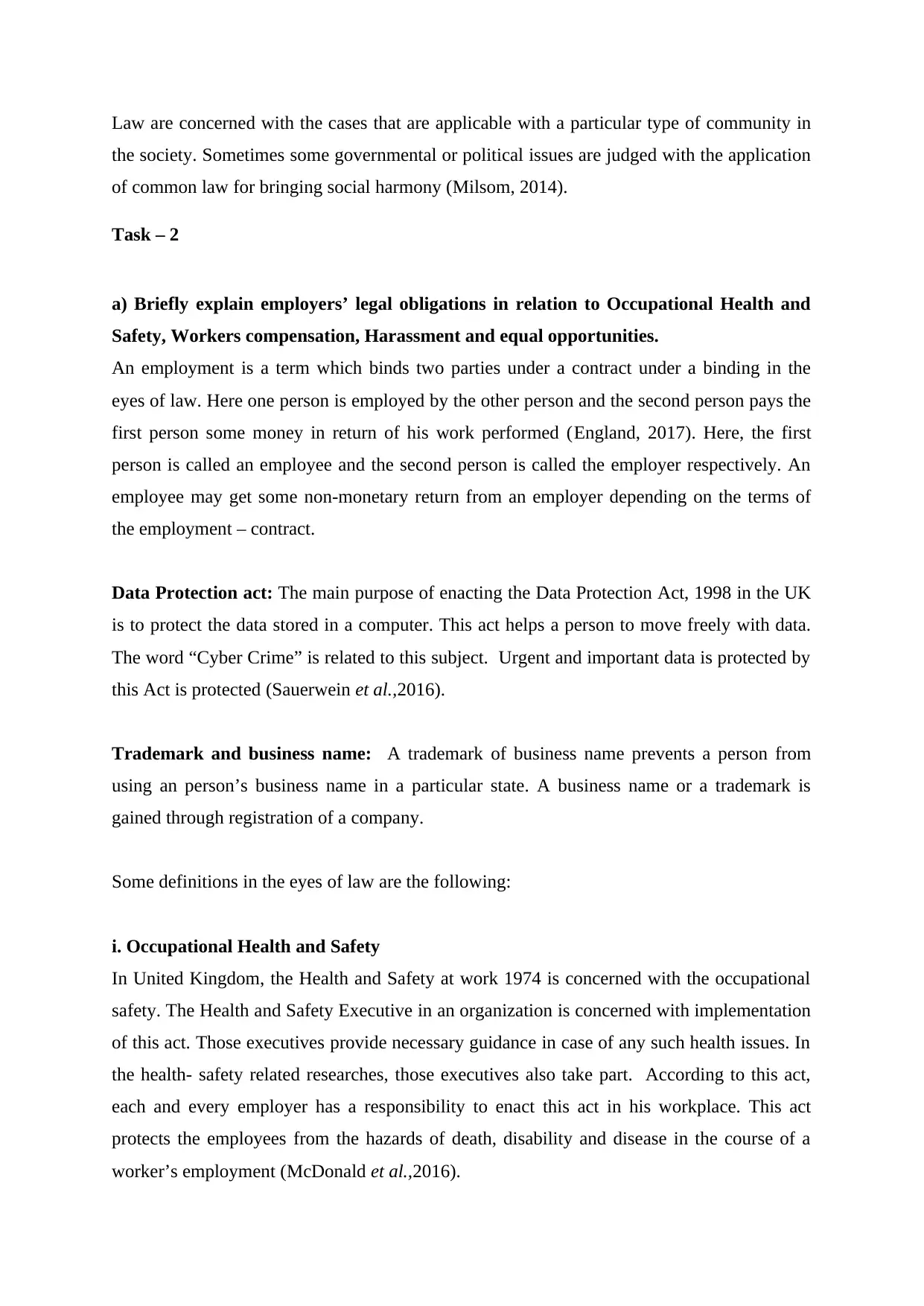
Law are concerned with the cases that are applicable with a particular type of community in
the society. Sometimes some governmental or political issues are judged with the application
of common law for bringing social harmony (Milsom, 2014).
Task – 2
a) Briefly explain employers’ legal obligations in relation to Occupational Health and
Safety, Workers compensation, Harassment and equal opportunities.
An employment is a term which binds two parties under a contract under a binding in the
eyes of law. Here one person is employed by the other person and the second person pays the
first person some money in return of his work performed (England, 2017). Here, the first
person is called an employee and the second person is called the employer respectively. An
employee may get some non-monetary return from an employer depending on the terms of
the employment – contract.
Data Protection act: The main purpose of enacting the Data Protection Act, 1998 in the UK
is to protect the data stored in a computer. This act helps a person to move freely with data.
The word “Cyber Crime” is related to this subject. Urgent and important data is protected by
this Act is protected (Sauerwein et al.,2016).
Trademark and business name: A trademark of business name prevents a person from
using an person’s business name in a particular state. A business name or a trademark is
gained through registration of a company.
Some definitions in the eyes of law are the following:
i. Occupational Health and Safety
In United Kingdom, the Health and Safety at work 1974 is concerned with the occupational
safety. The Health and Safety Executive in an organization is concerned with implementation
of this act. Those executives provide necessary guidance in case of any such health issues. In
the health- safety related researches, those executives also take part. According to this act,
each and every employer has a responsibility to enact this act in his workplace. This act
protects the employees from the hazards of death, disability and disease in the course of a
worker’s employment (McDonald et al.,2016).
the society. Sometimes some governmental or political issues are judged with the application
of common law for bringing social harmony (Milsom, 2014).
Task – 2
a) Briefly explain employers’ legal obligations in relation to Occupational Health and
Safety, Workers compensation, Harassment and equal opportunities.
An employment is a term which binds two parties under a contract under a binding in the
eyes of law. Here one person is employed by the other person and the second person pays the
first person some money in return of his work performed (England, 2017). Here, the first
person is called an employee and the second person is called the employer respectively. An
employee may get some non-monetary return from an employer depending on the terms of
the employment – contract.
Data Protection act: The main purpose of enacting the Data Protection Act, 1998 in the UK
is to protect the data stored in a computer. This act helps a person to move freely with data.
The word “Cyber Crime” is related to this subject. Urgent and important data is protected by
this Act is protected (Sauerwein et al.,2016).
Trademark and business name: A trademark of business name prevents a person from
using an person’s business name in a particular state. A business name or a trademark is
gained through registration of a company.
Some definitions in the eyes of law are the following:
i. Occupational Health and Safety
In United Kingdom, the Health and Safety at work 1974 is concerned with the occupational
safety. The Health and Safety Executive in an organization is concerned with implementation
of this act. Those executives provide necessary guidance in case of any such health issues. In
the health- safety related researches, those executives also take part. According to this act,
each and every employer has a responsibility to enact this act in his workplace. This act
protects the employees from the hazards of death, disability and disease in the course of a
worker’s employment (McDonald et al.,2016).
⊘ This is a preview!⊘
Do you want full access?
Subscribe today to unlock all pages.

Trusted by 1+ million students worldwide
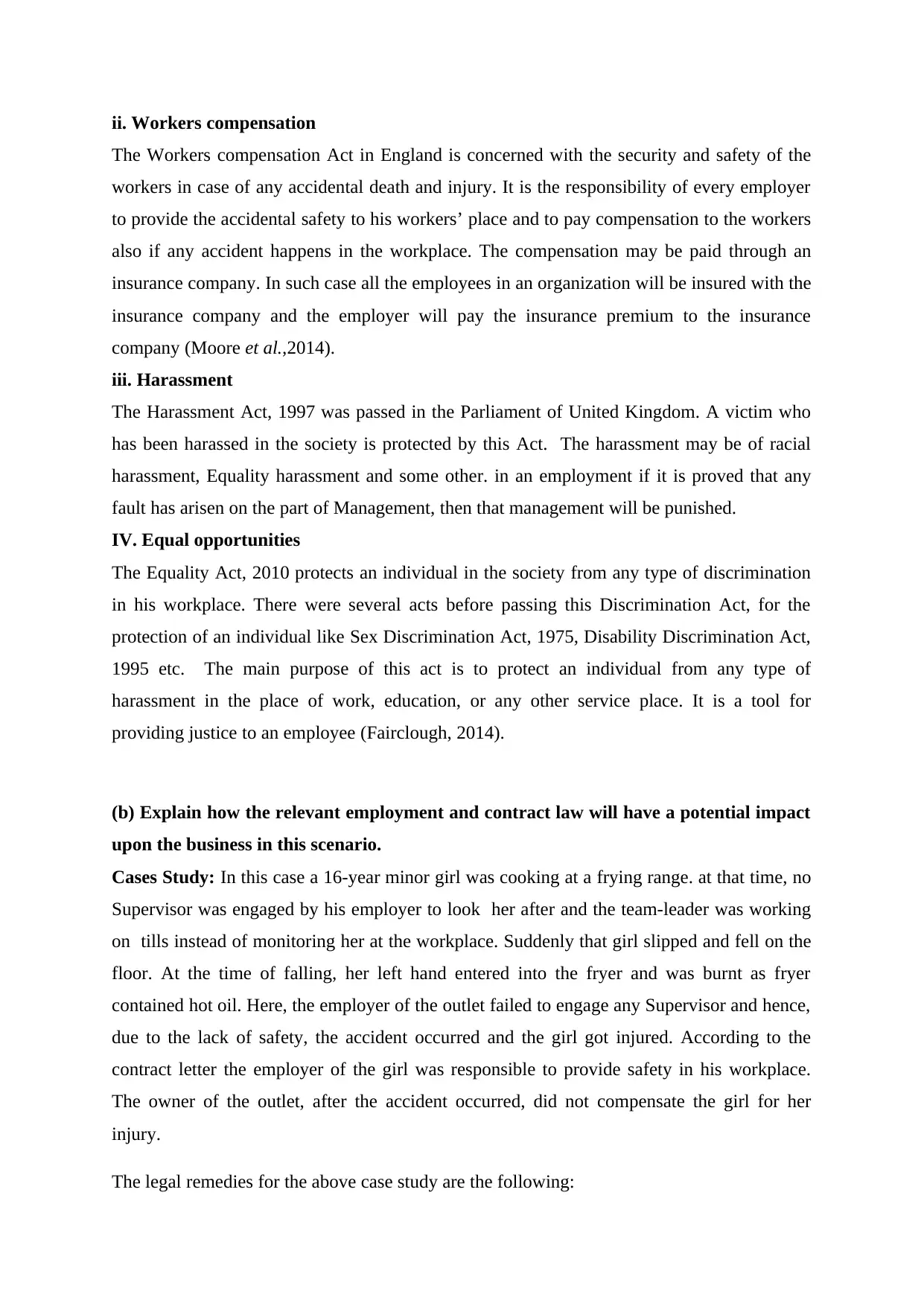
ii. Workers compensation
The Workers compensation Act in England is concerned with the security and safety of the
workers in case of any accidental death and injury. It is the responsibility of every employer
to provide the accidental safety to his workers’ place and to pay compensation to the workers
also if any accident happens in the workplace. The compensation may be paid through an
insurance company. In such case all the employees in an organization will be insured with the
insurance company and the employer will pay the insurance premium to the insurance
company (Moore et al.,2014).
iii. Harassment
The Harassment Act, 1997 was passed in the Parliament of United Kingdom. A victim who
has been harassed in the society is protected by this Act. The harassment may be of racial
harassment, Equality harassment and some other. in an employment if it is proved that any
fault has arisen on the part of Management, then that management will be punished.
IV. Equal opportunities
The Equality Act, 2010 protects an individual in the society from any type of discrimination
in his workplace. There were several acts before passing this Discrimination Act, for the
protection of an individual like Sex Discrimination Act, 1975, Disability Discrimination Act,
1995 etc. The main purpose of this act is to protect an individual from any type of
harassment in the place of work, education, or any other service place. It is a tool for
providing justice to an employee (Fairclough, 2014).
(b) Explain how the relevant employment and contract law will have a potential impact
upon the business in this scenario.
Cases Study: In this case a 16-year minor girl was cooking at a frying range. at that time, no
Supervisor was engaged by his employer to look her after and the team-leader was working
on tills instead of monitoring her at the workplace. Suddenly that girl slipped and fell on the
floor. At the time of falling, her left hand entered into the fryer and was burnt as fryer
contained hot oil. Here, the employer of the outlet failed to engage any Supervisor and hence,
due to the lack of safety, the accident occurred and the girl got injured. According to the
contract letter the employer of the girl was responsible to provide safety in his workplace.
The owner of the outlet, after the accident occurred, did not compensate the girl for her
injury.
The legal remedies for the above case study are the following:
The Workers compensation Act in England is concerned with the security and safety of the
workers in case of any accidental death and injury. It is the responsibility of every employer
to provide the accidental safety to his workers’ place and to pay compensation to the workers
also if any accident happens in the workplace. The compensation may be paid through an
insurance company. In such case all the employees in an organization will be insured with the
insurance company and the employer will pay the insurance premium to the insurance
company (Moore et al.,2014).
iii. Harassment
The Harassment Act, 1997 was passed in the Parliament of United Kingdom. A victim who
has been harassed in the society is protected by this Act. The harassment may be of racial
harassment, Equality harassment and some other. in an employment if it is proved that any
fault has arisen on the part of Management, then that management will be punished.
IV. Equal opportunities
The Equality Act, 2010 protects an individual in the society from any type of discrimination
in his workplace. There were several acts before passing this Discrimination Act, for the
protection of an individual like Sex Discrimination Act, 1975, Disability Discrimination Act,
1995 etc. The main purpose of this act is to protect an individual from any type of
harassment in the place of work, education, or any other service place. It is a tool for
providing justice to an employee (Fairclough, 2014).
(b) Explain how the relevant employment and contract law will have a potential impact
upon the business in this scenario.
Cases Study: In this case a 16-year minor girl was cooking at a frying range. at that time, no
Supervisor was engaged by his employer to look her after and the team-leader was working
on tills instead of monitoring her at the workplace. Suddenly that girl slipped and fell on the
floor. At the time of falling, her left hand entered into the fryer and was burnt as fryer
contained hot oil. Here, the employer of the outlet failed to engage any Supervisor and hence,
due to the lack of safety, the accident occurred and the girl got injured. According to the
contract letter the employer of the girl was responsible to provide safety in his workplace.
The owner of the outlet, after the accident occurred, did not compensate the girl for her
injury.
The legal remedies for the above case study are the following:
Paraphrase This Document
Need a fresh take? Get an instant paraphrase of this document with our AI Paraphraser
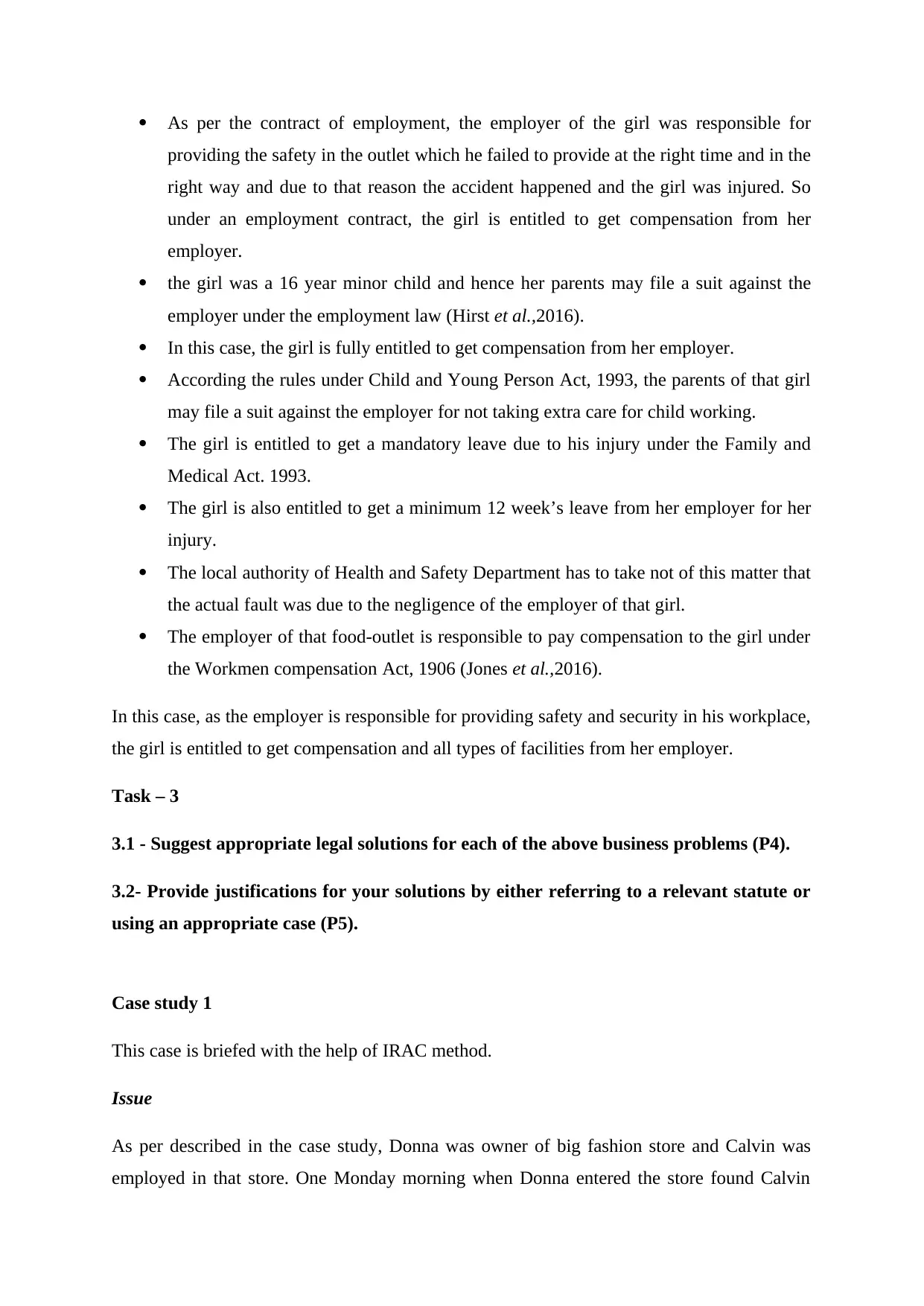
As per the contract of employment, the employer of the girl was responsible for
providing the safety in the outlet which he failed to provide at the right time and in the
right way and due to that reason the accident happened and the girl was injured. So
under an employment contract, the girl is entitled to get compensation from her
employer.
the girl was a 16 year minor child and hence her parents may file a suit against the
employer under the employment law (Hirst et al.,2016).
In this case, the girl is fully entitled to get compensation from her employer.
According the rules under Child and Young Person Act, 1993, the parents of that girl
may file a suit against the employer for not taking extra care for child working.
The girl is entitled to get a mandatory leave due to his injury under the Family and
Medical Act. 1993.
The girl is also entitled to get a minimum 12 week’s leave from her employer for her
injury.
The local authority of Health and Safety Department has to take not of this matter that
the actual fault was due to the negligence of the employer of that girl.
The employer of that food-outlet is responsible to pay compensation to the girl under
the Workmen compensation Act, 1906 (Jones et al.,2016).
In this case, as the employer is responsible for providing safety and security in his workplace,
the girl is entitled to get compensation and all types of facilities from her employer.
Task – 3
3.1 - Suggest appropriate legal solutions for each of the above business problems (P4).
3.2- Provide justifications for your solutions by either referring to a relevant statute or
using an appropriate case (P5).
Case study 1
This case is briefed with the help of IRAC method.
Issue
As per described in the case study, Donna was owner of big fashion store and Calvin was
employed in that store. One Monday morning when Donna entered the store found Calvin
providing the safety in the outlet which he failed to provide at the right time and in the
right way and due to that reason the accident happened and the girl was injured. So
under an employment contract, the girl is entitled to get compensation from her
employer.
the girl was a 16 year minor child and hence her parents may file a suit against the
employer under the employment law (Hirst et al.,2016).
In this case, the girl is fully entitled to get compensation from her employer.
According the rules under Child and Young Person Act, 1993, the parents of that girl
may file a suit against the employer for not taking extra care for child working.
The girl is entitled to get a mandatory leave due to his injury under the Family and
Medical Act. 1993.
The girl is also entitled to get a minimum 12 week’s leave from her employer for her
injury.
The local authority of Health and Safety Department has to take not of this matter that
the actual fault was due to the negligence of the employer of that girl.
The employer of that food-outlet is responsible to pay compensation to the girl under
the Workmen compensation Act, 1906 (Jones et al.,2016).
In this case, as the employer is responsible for providing safety and security in his workplace,
the girl is entitled to get compensation and all types of facilities from her employer.
Task – 3
3.1 - Suggest appropriate legal solutions for each of the above business problems (P4).
3.2- Provide justifications for your solutions by either referring to a relevant statute or
using an appropriate case (P5).
Case study 1
This case is briefed with the help of IRAC method.
Issue
As per described in the case study, Donna was owner of big fashion store and Calvin was
employed in that store. One Monday morning when Donna entered the store found Calvin
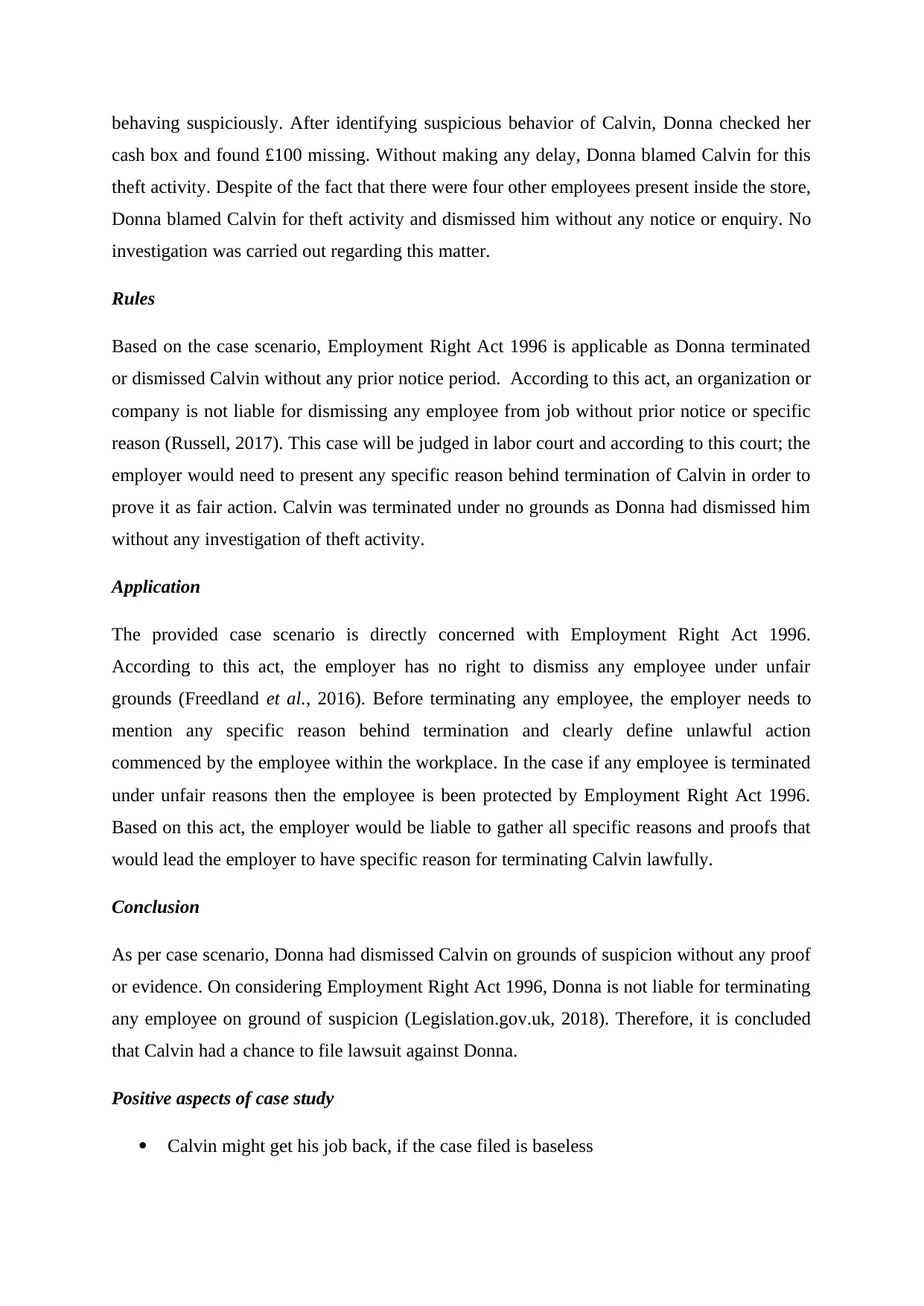
behaving suspiciously. After identifying suspicious behavior of Calvin, Donna checked her
cash box and found £100 missing. Without making any delay, Donna blamed Calvin for this
theft activity. Despite of the fact that there were four other employees present inside the store,
Donna blamed Calvin for theft activity and dismissed him without any notice or enquiry. No
investigation was carried out regarding this matter.
Rules
Based on the case scenario, Employment Right Act 1996 is applicable as Donna terminated
or dismissed Calvin without any prior notice period. According to this act, an organization or
company is not liable for dismissing any employee from job without prior notice or specific
reason (Russell, 2017). This case will be judged in labor court and according to this court; the
employer would need to present any specific reason behind termination of Calvin in order to
prove it as fair action. Calvin was terminated under no grounds as Donna had dismissed him
without any investigation of theft activity.
Application
The provided case scenario is directly concerned with Employment Right Act 1996.
According to this act, the employer has no right to dismiss any employee under unfair
grounds (Freedland et al., 2016). Before terminating any employee, the employer needs to
mention any specific reason behind termination and clearly define unlawful action
commenced by the employee within the workplace. In the case if any employee is terminated
under unfair reasons then the employee is been protected by Employment Right Act 1996.
Based on this act, the employer would be liable to gather all specific reasons and proofs that
would lead the employer to have specific reason for terminating Calvin lawfully.
Conclusion
As per case scenario, Donna had dismissed Calvin on grounds of suspicion without any proof
or evidence. On considering Employment Right Act 1996, Donna is not liable for terminating
any employee on ground of suspicion (Legislation.gov.uk, 2018). Therefore, it is concluded
that Calvin had a chance to file lawsuit against Donna.
Positive aspects of case study
Calvin might get his job back, if the case filed is baseless
cash box and found £100 missing. Without making any delay, Donna blamed Calvin for this
theft activity. Despite of the fact that there were four other employees present inside the store,
Donna blamed Calvin for theft activity and dismissed him without any notice or enquiry. No
investigation was carried out regarding this matter.
Rules
Based on the case scenario, Employment Right Act 1996 is applicable as Donna terminated
or dismissed Calvin without any prior notice period. According to this act, an organization or
company is not liable for dismissing any employee from job without prior notice or specific
reason (Russell, 2017). This case will be judged in labor court and according to this court; the
employer would need to present any specific reason behind termination of Calvin in order to
prove it as fair action. Calvin was terminated under no grounds as Donna had dismissed him
without any investigation of theft activity.
Application
The provided case scenario is directly concerned with Employment Right Act 1996.
According to this act, the employer has no right to dismiss any employee under unfair
grounds (Freedland et al., 2016). Before terminating any employee, the employer needs to
mention any specific reason behind termination and clearly define unlawful action
commenced by the employee within the workplace. In the case if any employee is terminated
under unfair reasons then the employee is been protected by Employment Right Act 1996.
Based on this act, the employer would be liable to gather all specific reasons and proofs that
would lead the employer to have specific reason for terminating Calvin lawfully.
Conclusion
As per case scenario, Donna had dismissed Calvin on grounds of suspicion without any proof
or evidence. On considering Employment Right Act 1996, Donna is not liable for terminating
any employee on ground of suspicion (Legislation.gov.uk, 2018). Therefore, it is concluded
that Calvin had a chance to file lawsuit against Donna.
Positive aspects of case study
Calvin might get his job back, if the case filed is baseless
⊘ This is a preview!⊘
Do you want full access?
Subscribe today to unlock all pages.

Trusted by 1+ million students worldwide
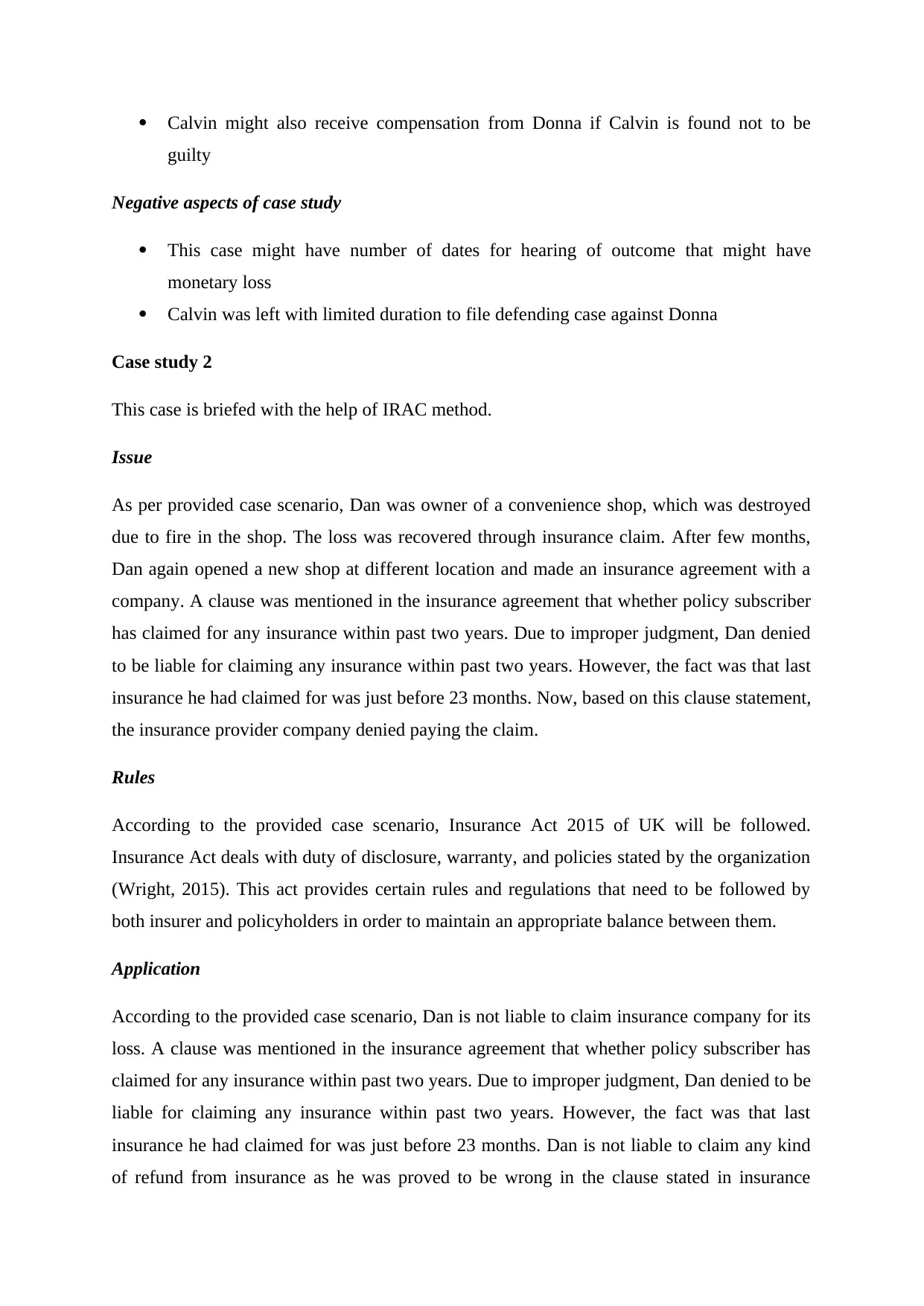
Calvin might also receive compensation from Donna if Calvin is found not to be
guilty
Negative aspects of case study
This case might have number of dates for hearing of outcome that might have
monetary loss
Calvin was left with limited duration to file defending case against Donna
Case study 2
This case is briefed with the help of IRAC method.
Issue
As per provided case scenario, Dan was owner of a convenience shop, which was destroyed
due to fire in the shop. The loss was recovered through insurance claim. After few months,
Dan again opened a new shop at different location and made an insurance agreement with a
company. A clause was mentioned in the insurance agreement that whether policy subscriber
has claimed for any insurance within past two years. Due to improper judgment, Dan denied
to be liable for claiming any insurance within past two years. However, the fact was that last
insurance he had claimed for was just before 23 months. Now, based on this clause statement,
the insurance provider company denied paying the claim.
Rules
According to the provided case scenario, Insurance Act 2015 of UK will be followed.
Insurance Act deals with duty of disclosure, warranty, and policies stated by the organization
(Wright, 2015). This act provides certain rules and regulations that need to be followed by
both insurer and policyholders in order to maintain an appropriate balance between them.
Application
According to the provided case scenario, Dan is not liable to claim insurance company for its
loss. A clause was mentioned in the insurance agreement that whether policy subscriber has
claimed for any insurance within past two years. Due to improper judgment, Dan denied to be
liable for claiming any insurance within past two years. However, the fact was that last
insurance he had claimed for was just before 23 months. Dan is not liable to claim any kind
of refund from insurance as he was proved to be wrong in the clause stated in insurance
guilty
Negative aspects of case study
This case might have number of dates for hearing of outcome that might have
monetary loss
Calvin was left with limited duration to file defending case against Donna
Case study 2
This case is briefed with the help of IRAC method.
Issue
As per provided case scenario, Dan was owner of a convenience shop, which was destroyed
due to fire in the shop. The loss was recovered through insurance claim. After few months,
Dan again opened a new shop at different location and made an insurance agreement with a
company. A clause was mentioned in the insurance agreement that whether policy subscriber
has claimed for any insurance within past two years. Due to improper judgment, Dan denied
to be liable for claiming any insurance within past two years. However, the fact was that last
insurance he had claimed for was just before 23 months. Now, based on this clause statement,
the insurance provider company denied paying the claim.
Rules
According to the provided case scenario, Insurance Act 2015 of UK will be followed.
Insurance Act deals with duty of disclosure, warranty, and policies stated by the organization
(Wright, 2015). This act provides certain rules and regulations that need to be followed by
both insurer and policyholders in order to maintain an appropriate balance between them.
Application
According to the provided case scenario, Dan is not liable to claim insurance company for its
loss. A clause was mentioned in the insurance agreement that whether policy subscriber has
claimed for any insurance within past two years. Due to improper judgment, Dan denied to be
liable for claiming any insurance within past two years. However, the fact was that last
insurance he had claimed for was just before 23 months. Dan is not liable to claim any kind
of refund from insurance as he was proved to be wrong in the clause stated in insurance
Paraphrase This Document
Need a fresh take? Get an instant paraphrase of this document with our AI Paraphraser
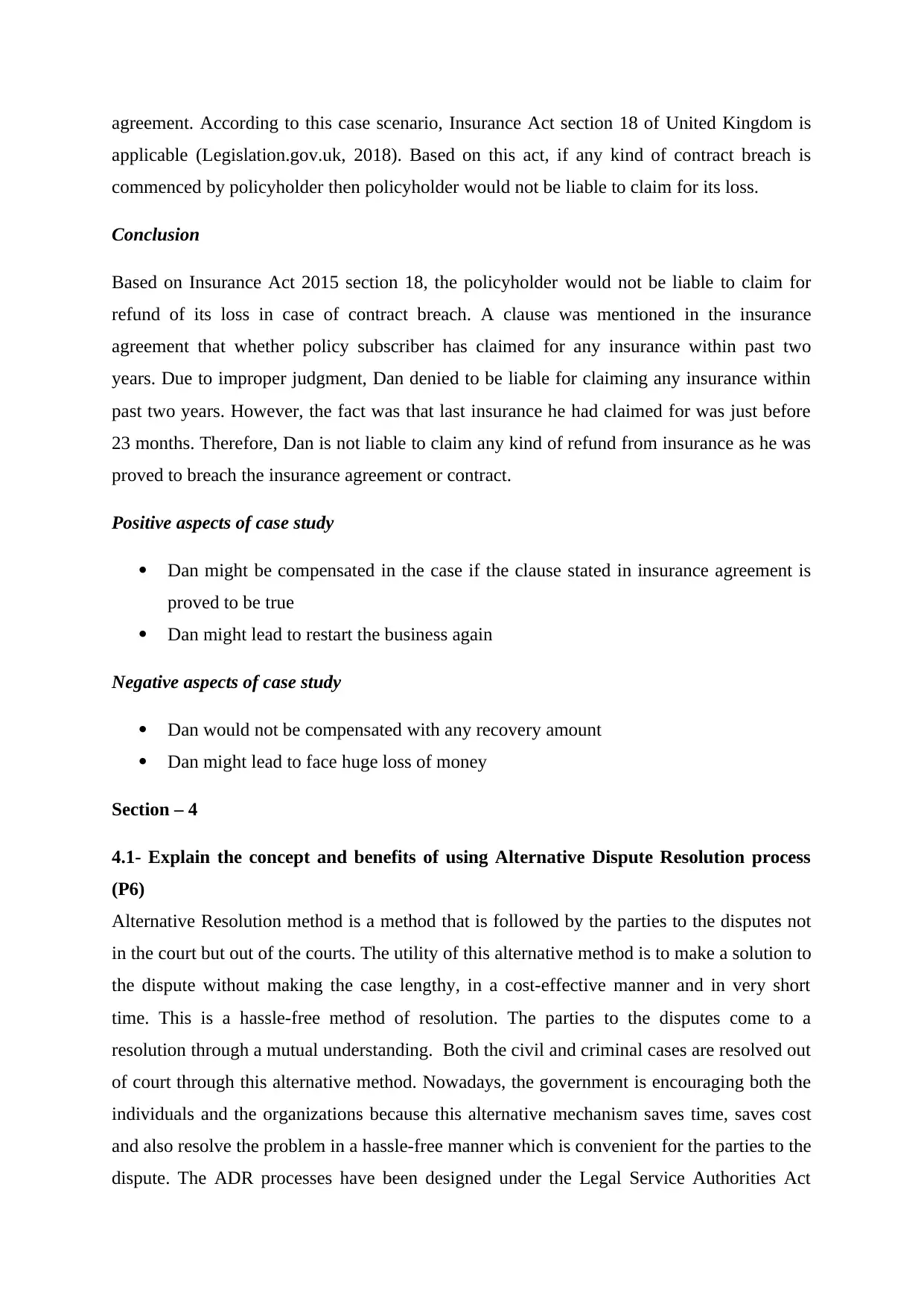
agreement. According to this case scenario, Insurance Act section 18 of United Kingdom is
applicable (Legislation.gov.uk, 2018). Based on this act, if any kind of contract breach is
commenced by policyholder then policyholder would not be liable to claim for its loss.
Conclusion
Based on Insurance Act 2015 section 18, the policyholder would not be liable to claim for
refund of its loss in case of contract breach. A clause was mentioned in the insurance
agreement that whether policy subscriber has claimed for any insurance within past two
years. Due to improper judgment, Dan denied to be liable for claiming any insurance within
past two years. However, the fact was that last insurance he had claimed for was just before
23 months. Therefore, Dan is not liable to claim any kind of refund from insurance as he was
proved to breach the insurance agreement or contract.
Positive aspects of case study
Dan might be compensated in the case if the clause stated in insurance agreement is
proved to be true
Dan might lead to restart the business again
Negative aspects of case study
Dan would not be compensated with any recovery amount
Dan might lead to face huge loss of money
Section – 4
4.1- Explain the concept and benefits of using Alternative Dispute Resolution process
(P6)
Alternative Resolution method is a method that is followed by the parties to the disputes not
in the court but out of the courts. The utility of this alternative method is to make a solution to
the dispute without making the case lengthy, in a cost-effective manner and in very short
time. This is a hassle-free method of resolution. The parties to the disputes come to a
resolution through a mutual understanding. Both the civil and criminal cases are resolved out
of court through this alternative method. Nowadays, the government is encouraging both the
individuals and the organizations because this alternative mechanism saves time, saves cost
and also resolve the problem in a hassle-free manner which is convenient for the parties to the
dispute. The ADR processes have been designed under the Legal Service Authorities Act
applicable (Legislation.gov.uk, 2018). Based on this act, if any kind of contract breach is
commenced by policyholder then policyholder would not be liable to claim for its loss.
Conclusion
Based on Insurance Act 2015 section 18, the policyholder would not be liable to claim for
refund of its loss in case of contract breach. A clause was mentioned in the insurance
agreement that whether policy subscriber has claimed for any insurance within past two
years. Due to improper judgment, Dan denied to be liable for claiming any insurance within
past two years. However, the fact was that last insurance he had claimed for was just before
23 months. Therefore, Dan is not liable to claim any kind of refund from insurance as he was
proved to breach the insurance agreement or contract.
Positive aspects of case study
Dan might be compensated in the case if the clause stated in insurance agreement is
proved to be true
Dan might lead to restart the business again
Negative aspects of case study
Dan would not be compensated with any recovery amount
Dan might lead to face huge loss of money
Section – 4
4.1- Explain the concept and benefits of using Alternative Dispute Resolution process
(P6)
Alternative Resolution method is a method that is followed by the parties to the disputes not
in the court but out of the courts. The utility of this alternative method is to make a solution to
the dispute without making the case lengthy, in a cost-effective manner and in very short
time. This is a hassle-free method of resolution. The parties to the disputes come to a
resolution through a mutual understanding. Both the civil and criminal cases are resolved out
of court through this alternative method. Nowadays, the government is encouraging both the
individuals and the organizations because this alternative mechanism saves time, saves cost
and also resolve the problem in a hassle-free manner which is convenient for the parties to the
dispute. The ADR processes have been designed under the Legal Service Authorities Act
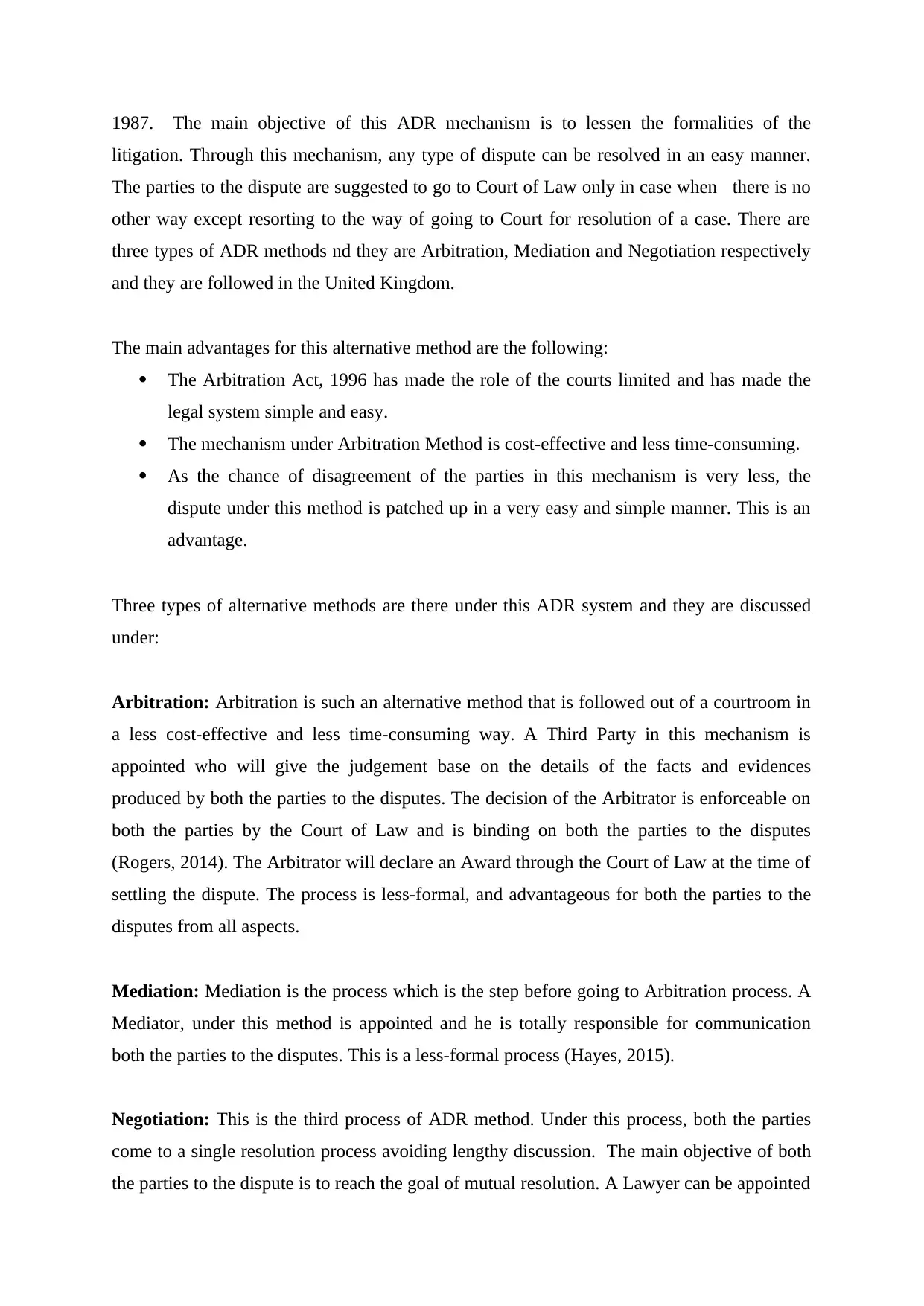
1987. The main objective of this ADR mechanism is to lessen the formalities of the
litigation. Through this mechanism, any type of dispute can be resolved in an easy manner.
The parties to the dispute are suggested to go to Court of Law only in case when there is no
other way except resorting to the way of going to Court for resolution of a case. There are
three types of ADR methods nd they are Arbitration, Mediation and Negotiation respectively
and they are followed in the United Kingdom.
The main advantages for this alternative method are the following:
The Arbitration Act, 1996 has made the role of the courts limited and has made the
legal system simple and easy.
The mechanism under Arbitration Method is cost-effective and less time-consuming.
As the chance of disagreement of the parties in this mechanism is very less, the
dispute under this method is patched up in a very easy and simple manner. This is an
advantage.
Three types of alternative methods are there under this ADR system and they are discussed
under:
Arbitration: Arbitration is such an alternative method that is followed out of a courtroom in
a less cost-effective and less time-consuming way. A Third Party in this mechanism is
appointed who will give the judgement base on the details of the facts and evidences
produced by both the parties to the disputes. The decision of the Arbitrator is enforceable on
both the parties by the Court of Law and is binding on both the parties to the disputes
(Rogers, 2014). The Arbitrator will declare an Award through the Court of Law at the time of
settling the dispute. The process is less-formal, and advantageous for both the parties to the
disputes from all aspects.
Mediation: Mediation is the process which is the step before going to Arbitration process. A
Mediator, under this method is appointed and he is totally responsible for communication
both the parties to the disputes. This is a less-formal process (Hayes, 2015).
Negotiation: This is the third process of ADR method. Under this process, both the parties
come to a single resolution process avoiding lengthy discussion. The main objective of both
the parties to the dispute is to reach the goal of mutual resolution. A Lawyer can be appointed
litigation. Through this mechanism, any type of dispute can be resolved in an easy manner.
The parties to the dispute are suggested to go to Court of Law only in case when there is no
other way except resorting to the way of going to Court for resolution of a case. There are
three types of ADR methods nd they are Arbitration, Mediation and Negotiation respectively
and they are followed in the United Kingdom.
The main advantages for this alternative method are the following:
The Arbitration Act, 1996 has made the role of the courts limited and has made the
legal system simple and easy.
The mechanism under Arbitration Method is cost-effective and less time-consuming.
As the chance of disagreement of the parties in this mechanism is very less, the
dispute under this method is patched up in a very easy and simple manner. This is an
advantage.
Three types of alternative methods are there under this ADR system and they are discussed
under:
Arbitration: Arbitration is such an alternative method that is followed out of a courtroom in
a less cost-effective and less time-consuming way. A Third Party in this mechanism is
appointed who will give the judgement base on the details of the facts and evidences
produced by both the parties to the disputes. The decision of the Arbitrator is enforceable on
both the parties by the Court of Law and is binding on both the parties to the disputes
(Rogers, 2014). The Arbitrator will declare an Award through the Court of Law at the time of
settling the dispute. The process is less-formal, and advantageous for both the parties to the
disputes from all aspects.
Mediation: Mediation is the process which is the step before going to Arbitration process. A
Mediator, under this method is appointed and he is totally responsible for communication
both the parties to the disputes. This is a less-formal process (Hayes, 2015).
Negotiation: This is the third process of ADR method. Under this process, both the parties
come to a single resolution process avoiding lengthy discussion. The main objective of both
the parties to the dispute is to reach the goal of mutual resolution. A Lawyer can be appointed
⊘ This is a preview!⊘
Do you want full access?
Subscribe today to unlock all pages.

Trusted by 1+ million students worldwide
1 out of 16
Related Documents
Your All-in-One AI-Powered Toolkit for Academic Success.
+13062052269
info@desklib.com
Available 24*7 on WhatsApp / Email
![[object Object]](/_next/static/media/star-bottom.7253800d.svg)
Unlock your academic potential
Copyright © 2020–2026 A2Z Services. All Rights Reserved. Developed and managed by ZUCOL.





